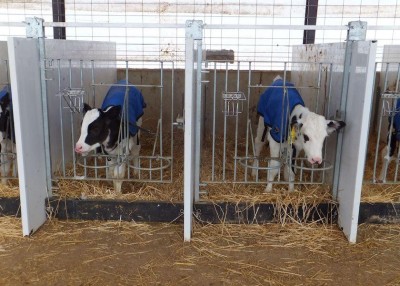Calf Jacket Rules of Thumb - Dairy Herd Management

Heat stress may still be an issue in some parts of the country, but winter's chill isn't far away.
By MAUREEN HANSON September 11, 2022
One way to help calves thrive through cold conditions is protecting them with calf jackets. And anyone who uses calf jackets has their own practices and preferences for implementing them. Among those "rules of thumb" shared by the experts in the trenches are:
From Minnie Ward at Calf Star:
When we start wearing hoodies in the fall, calf jackets should go on.
From Marissa Hake, DVM, "Dr. Hake -- Calf Vet":
- If the ground is frozen and the calf is less than 21 days old, it should have a calf jacket.
- DO NOT put a calf jacket on a wet calf. That trapped moisture will chill the calf instead of keeping it warmer. Make sure newborns are fully dry before putting jackets on.
- Wet jackets = BAD. If a jacket gets wet or covered with manure, remove and replace it with a clean, dry jacket.
- After 21 days of age, calves become better at thermoregulation. Weather/health permitting, jackets can be removed at this age.
- If there is a need to leave jackets on for longer than 3 weeks, make sure the straps don't dig in.
From "Starting Strong" by Vita Plus:
- Follow the "Rule of 90" - when the high and low ambient temperature total 90°F or less, calves less than 3 weeks old should have a jacket on.
- Don't wait until weaning to remove calf jackets. Doing so will add another level of stress to an already stressful time. Removing jackets when calves begin generating more body heat by beginning ruminating -- but while they are still on milk - will allow them to adapt to their new environment when the added protection of the jacket is removed.
As spring approaches, remove jackets as daytime temperatures warm up to ensure the calves are not "sweating" under their jackets.
And from Penn State Dairy Extension:
- Don't wait until weaning to remove calf jackets. Doing so will add another level of stress to an already stressful time. Removing jackets when calves begin generating more body heat by beginning ruminating -- but while they are still on milk - will allow them to adapt to their new environment when the added protection of the jacket is removed.
Upcoming Events
Crops, Cows & Critters - Southwest New York Dairy, Livestock & Field Crops Newsletter Sponsorship
December 19, 2025
Our two forms of publications feature research-based and timely information from our four specialists, listed to the right, along with local event notifications and Cornell University outreach. This information is provided to participants who range from dairy, livestock, and field crops producers to agricultural suppliers and consultants.
Weekly Email Update: Shared with 625+ households who have signed up with our program.
Monthly Paper Mailer: To reach our stakeholders and farmers who lack internet access, we send out a monthly mailer where your company's logo and contact information would be featured with a mailing list of 330+ households.
If you sponsor our weekly and monthly publications you reach approximately 955 households.
Visit our website to view our newsletters!
2025 Cornell Food Beverage & Animal Feed Manufacturer Survey
December 19, 2025
Industry and Educational Advocates for New York State's Food, Beverage, and Animal Feed Manufacturing industries:
As you know, NYS has a diverse food and beverage manufacturing industry, in both the types of industries that exist and the wide distribution of firms by scale. Many manufacturing firms have strong backward linkages to agricultural production sectors in the state that support both farm-level and downstream food industry firms and consumers. In collaboration with the New York State Department of Agriculture and Markets, a team from Cornell University's Charles H. Dyson School of Applied Economics and Management has recently rolled out the 2025 New York State Food, Beverage, and Animal Feed Manufacturer Survey. The industry will benefit from an updated assessment of the industry that informs private and public investments and opportunities to support firm growth and improved profitability.
Boots in the Barn: Cornell Dairy Research Updates
January 13, 2026
January 20, 2026
January 27, 2026
February 3, 2026
February 10, 2026
February 17, 2026
February 24, 2026
Join us for some or all!
Announcements
No announcements at this time.





